Crowdsourcing and Digital Information: Looking for a Future Research Agenda
Abstract
1. Introduction
2. Materials and Methods
3. Results
3.1. The Status and Evolution of Crowdsourcing and Digital Information in the Literature
3.2. Analysis of Citation and Co-Citation of Papers
3.2.1. Most Cited Papers in CDI
3.2.2. References Co-Citation Analysis
3.3. Analysis of Citation and Co-Citation of Sources
3.3.1. Leading CDI Areas and Journals
3.3.2. Journal Co-Citation Analysis
3.4. Co-Occurrence Analysis of “Author Keywords”
3.5. Authors Co-Citation Network and Bibliographic Coupling of Authors
4. Discussion and Conclusions
4.1. Theorical Implications and Research Agenda
4.1.1. Computer Science
4.1.2. Engineering and Information Science and Library Science
4.1.3. Management
4.1.4. Psychology, Law, Ethics Marketing, Economics
4.1.5. Geography and Citizen Science
4.1.6. Medicine
4.1.7. Others
4.2. Practical Implications
4.3. Limitations and Future Research
Author Contributions
Funding
Institutional Review Board Statement
Informed Consent Statement
Data Availability Statement
Acknowledgments
Conflicts of Interest
References
- Howe, J. The rise of crowdsourcing. Wired Mag. 2006, 14, 176–183. [Google Scholar]
- Garrigos-Simon, F.J.; Lapiedra Alcami, R.; Barbera Ribera, T. Social Networks and Web 3.0: Their impact on the management and marketing of organizations. Manag. Decis. 2012, 50, 1880–1890. [Google Scholar] [CrossRef]
- Garrigos-Simon, F.J.; Narangajavana, Y. From Crowdsourcing to the Use of Masscapital. The Common Perspective of the Success of Apple, Facebook, Google, Lego, TripAdvisor, and Zara. In Advances in Crowdsourcing; Garrigos, F., Gil, I., Estelles, S., Eds.; Springer: Cham, Switzerland, 2015; pp. 1–13. [Google Scholar]
- Garrigos-Simon, F.J.; Narangajavana-Kaosiri, Y. Crowdsourcing: A Systematic Literature Review and Future Research Agenda. Eur. J. Stud. Manag. Bus. 2024, 30, 1–26. [Google Scholar] [CrossRef]
- Boudreau, K.J.; Lakhani, K.R. Using the crowd as an innovation partner. Harv. Bus. Rev. 2013, 91, 60–69. [Google Scholar]
- Garrigos-Simon, F.J.; Narangajavana, Y.; Galdón-Salvador, J.L. Crowdsourcing as a competitive advantage for new business models. In Strategies in E-Business; Gil, I., Palacios, D., Peris, M., Vendrell, E., Ramirez, C., Eds.; Springer: Boston, MA, USA, 2014; pp. 29–37. [Google Scholar]
- Bañón-Gomis, A.J.; Martínez-Cañas, R.; Ruiz-Palomino, P. Humanizing Internal Crowdsourcing Best Practices. In Advances in Crowdsourcing; Garrigos, F., Gil, I., Estelles, S., Eds.; Springer: Cham, Switzerland, 2015; pp. 105–117. [Google Scholar]
- Wilson, M.; Robson, K.; Botha, E. Crowdsourcing in a time of empowered stakeholders: Lessons from crowdsourcing campaigns. Bus. Horiz. 2017, 60, 247–253. [Google Scholar] [CrossRef]
- Nikooghadam, M.; Shahriari, H.R. Verifiable and secure data sharing in crowdsourcing-based healthcare. J. Supercomput. 2025, 81, 685. [Google Scholar] [CrossRef]
- Song, M.; Gong, X.; Jiao, R.J.; Moore, R. A blockchain-enabled information as a service (IaaS) system for crowdsourced manufacturing: A crowdsourcing case study of tank trailer manufacturing. J. Ind. Inf. Integr. 2025, 45, 100844. [Google Scholar] [CrossRef]
- Blohm, I.; Zogaj, S.; Bretschneider, U.; Leimeister, J.M. How to manage crowdsourcing platforms effectively? Calif. Manag. Rev. 2018, 60, 122–149. [Google Scholar] [CrossRef]
- Brabham, D.C. Crowdsourcing as a model for problem solving: An introduction and cases. Convergence 2008, 14, 75–90. [Google Scholar] [CrossRef]
- Kleemann, F.; Voß, G.G.; Rieder, K. Un(der)paid innovators: The commercial utilization of consumer work through crowdsourcing. Sci. Technol. Innov. Stud. 2008, 4, 5–26. [Google Scholar]
- Wang, L.; Xia, E.; Li, H.; Wang, W. A Bibliometric analysis of crowdsourcing in the field of public health. Int. J. Environ. Res. Public Health 2019, 16, 3825. [Google Scholar] [CrossRef]
- Lebraty, J.F.; Lobre-Lebraty, K. Crowdsourcing: One Step Beyond; John Wiley & Sons: Hoboken, NJ, USA, 2013. [Google Scholar]
- Garrigos-Simon, F.J.; Galdon, J.L.; Sanz-Blas, S. Effects of crowdvoting on hotels: The Booking.com case. Int. J. Contemp. Hosp. Manag. 2017, 29, 419–437. [Google Scholar] [CrossRef]
- Liao, H.; Tang, M.; Luo, L.; Li, C.; Chiclana, F.; Zeng, X.J. A bibliometric analysis and visualization of medical big data research. Sustainability 2018, 10, 166. [Google Scholar] [CrossRef]
- Osareh, F. Bibliometrics, Citation Analysis and co-citation analysis: A review of literature I. Libri 1996, 46, 221–225. [Google Scholar] [CrossRef]
- López-Meneses, E.; Vázquez-Cano, E.; Román, P. Analysis and Implications of the Impact of MOOC Movement in the Scientific Community: JCR and Scopus (2010–13). Comunicar 2015, 22, 73–80. [Google Scholar] [CrossRef]
- Merigó, J.M.; Yang, J.B. Accounting research: A bibliometric analysis. Aust. Account. Rev. 2017, 27, 71–100. [Google Scholar] [CrossRef]
- Garrigos-Simon, F.J.; Narangajavana-Kaosiri, Y.; Lengua-Lengua, I. Tourism and Sustainability: A Bibliometric and Visualization Analysis. Sustainability 2018, 10, 1976. [Google Scholar] [CrossRef]
- Hirsch, J.E. An index to quantify an individual’s scientific research output. Proc. Natl. Acad. Sci. USA 2005, 102, 16569–16572. [Google Scholar] [CrossRef]
- Blanco-Mesa, F.; Merigó, J.M.; Gil-Lafuente, A.M. Fuzzy decision making: A bibliometric-based review. J. Intell. Fuzzy Syst. 2017, 32, 2033–2050. [Google Scholar] [CrossRef]
- Van Eck, N.J.; Waltman, L. Software survey: VOSviewer, a computer program for bibliometric mapping. Scientometrics 2010, 84, 523–538. [Google Scholar] [CrossRef]
- Small, H. Co-citation in the scientific literature: A new measure of the relationship between two documents. J. Am. Soc. Inf. Sci. 1973, 24, 265–269. [Google Scholar] [CrossRef]
- Kessler, M.M. Bibliographic coupling between scientific papers. J. Assoc. Inf. Sci. Technol. 1963, 14, 10–25. [Google Scholar] [CrossRef]
- Trainor, C. Open source, crowd source: Harnessing the power of the people behind our libraries. Program 2009, 43, 288–298. [Google Scholar] [CrossRef]
- Pennycook, G.; Rand, D.G. The psychology of fake news. Trends Cogn. Sci. 2021, 25, 388–402. [Google Scholar] [CrossRef]
- Wu, D.; Rosen, D.W.; Wang, L.; Schaefer, D. Cloud-Based design and manufacturing: A new paradigm in digital manufacturing and design innovation. Comput.-Aided Des. 2015, 59, 1–14. [Google Scholar] [CrossRef]
- Steelman, Z.R.; Hammer, B.I.; Limayem, M. Data collection in the digital age. MIS Q. 2014, 38, 355–378. [Google Scholar] [CrossRef]
- Tangcharoensathien, V.; Calleja, N.; Nguyen, T.; Purnat, T.; D’Agostino, M.; Garcia-Saiso, S.; Landry, M.; Rashidian, A.; Hamilton, C.; AbdAllah, A.; et al. Framework for managing the COVID-19 Infodemic: Methods and results of an online, crowdsourced WHO technical consultation. J. Med. Internet Res. 2020, 22, e19659. [Google Scholar] [CrossRef]
- Goodchild, M.F. Citizens as Sensors: The world of volunteered geography. GeoJournal 2007, 69, 211–221. [Google Scholar] [CrossRef]
- Estellés-Arolas, E.; González-Ladrón-De-Guevara, F. Towards an integrated crowdsourcing definition. J. Inf. Sci. 2012, 38, 189–200. [Google Scholar] [CrossRef]
- Zook, M.; Graham, M.; Shelton, T.; Gorman, S. Volunteered geographic information and crowdsourcing disaster relief: A case study of the Haitian earthquake. World Med. Health Policy 2010, 2, 7–33. [Google Scholar] [CrossRef]
- Bonney, R.; Cooper, C.B.; Dickinson, J.; Kelling, S.; Phillips, T.; Rosenberg, K.V.; Shirk, J. Citizen science: A developing tool for expanding science knowledge and scientific literacy. BioScience 2009, 59, 977–984. [Google Scholar] [CrossRef]
- Goodchild, M.F.; Li, L. Assuring the quality of volunteered geographic information. Spat. Stat. 2012, 1, 110–120. [Google Scholar] [CrossRef]
- Haklay, M. How good is volunteered geographical information? A comparative study of OpenStreetMap and Ordnance Survey datasets. Environ. Plan. B Plan. Des. 2010, 37, 682–703. [Google Scholar] [CrossRef]
- Afuah, A.; Tucci, C.L. Crowdsourcing as a solution to distant search. Acad. Manag. Rev. 2012, 37, 355–375. [Google Scholar] [CrossRef]
- Fornell, C.; Larcker, D.F. Evaluating structural equation models with unobservable variables and measurement error. J. Mark. Res. 1981, 18, 39–50. [Google Scholar] [CrossRef]
- Brabham, D.C. Moving the crowd at threadless: Motivations for participation in a crowdsourcing application. Inf. Commun. Soc. 2010, 13, 1122–1145. [Google Scholar] [CrossRef]
- Brabham, D.C. Crowdsourcing; MIT Press: Cambridge, MA, USA, 2013. [Google Scholar]
- Howe, J. Crowdsourcing: Why the Power of the Crowd Is Driving the Future of Business; Crown Business: New York, NY, USA, 2009. [Google Scholar]
- Braun, V.; Clarke, V. One Size Fits All? What counts as quality practice in (reflexive) thematic analysis? Qual. Res. Psychol. 2021, 18, 328–352. [Google Scholar] [CrossRef]
- Mollick, E. The Dynamics of crowdfunding: An exploratory study. J. Bus. Ventur. 2014, 29, 1–16. [Google Scholar] [CrossRef]
- Belleflamme, P.; Lambert, T.; Schwienbacher, A. crowdfunding: Tapping the right crowd. J. Bus. Ventur. 2014, 29, 585–609. [Google Scholar] [CrossRef]
- Gao, H.; Barbier, G.; Goolsby, R. Harnessing the crowdsourcing power of social media for disaster relief. IEEE Intell. Syst. 2011, 26, 10–14. [Google Scholar] [CrossRef]
- Majchrzak, A.; Malhotra, A. Towards an information systems perspective and research agenda on crowdsourcing for innovation. J. Strateg. Inf. Syst. 2013, 22, 257–268. [Google Scholar] [CrossRef]
- Zhao, Y.; Zhu, Q. Evaluation on crowdsourcing research: Current status and future direction. Inf. Syst. Front. 2014, 16, 417–434. [Google Scholar] [CrossRef]
- Nonaka, I.; Takeuchi, H. The Knowledge-Creating Company: How Japanese Companies Create the Dynamics of Innovation; Oxford University Press: Oxford, UK, 1995. [Google Scholar]
- Davenport, T.H.; Prusak, L. Working Knowledge: How Organizations Manage What They Know; Harvard Business Press: Boston, MA, USA, 1998. [Google Scholar]
- Ghezzi, A.; Gabelloni, D.; Martini, A.; Natalicchio, A. Crowdsourcing: A review and suggestions for future research. Int. J. Manag. Rev. 2018, 20, 343–363. [Google Scholar] [CrossRef]
- Kietzmann, J.H. Crowdsourcing: A revised definition and an introduction to new research. Bus. Horiz. 2017, 60, 151–153. [Google Scholar] [CrossRef]
- Gkeli, M.; Potsiou, C. 3D Crowdsourced parametric cadastral mapping: Pathways integrating BIM/IFC, crowdsourced data and LADM. Land Use Policy 2023, 131, 106713. [Google Scholar] [CrossRef]
- Liu, P.; Zhao, T.; Luo, J.; Lei, B.; Frei, M.; Miller, C.; Biljecki, F. Towards human-centric digital twins: Leveraging computer vision and graph models to predict outdoor comfort. Sustain. Cities Soc. 2023, 93, 104480. [Google Scholar] [CrossRef]
- Fieseler, C.; Bucher, E.; Hoffmann, C.P. Unfairness by Design? the perceived fairness of digital labor on crowdworking platforms. J. Bus. Ethics 2019, 156, 987–1005. [Google Scholar] [CrossRef]
- Zhang, L.; Wang, X.; Lin, H.; Piran, M.J. A Crowdsourcing logistics solution based on digital twin and four-party evolutionary game. Eng. Appl. Artif. Intell. 2024, 130, 107797. [Google Scholar] [CrossRef]
- Hajiheydari, N.; Delgosha, M.S. Citizens’ support in social mission platforms: Unravelling configurations for participating in civic crowdfunding platforms. Technol. Forecast. Soc. Change 2023, 189, 122366. [Google Scholar] [CrossRef]
- Gong, X.; Song, M.; Wang, S.; Jiao, R.J.; Helo, P. Crowdsourced Manufacturing in Industry 4.0: Implications and Prospects. Systems 2025, 13, 183. [Google Scholar] [CrossRef]
- Taylor, J.; Joshi, K.D. Joining the crowd: The career anchors of information technology workers participating in crowdsourcing. Inf. Syst. J. 2019, 29, 641–673. [Google Scholar] [CrossRef]
- Narangajavana, Y.; Gonzalez-Cruz, T.; Garrigos-Simon, F.J.; Cruz-Ros, S. Measuring social entrepreneurship and social value with leakage. definition, analysis and policies for the hospitality industry. Int. Entrep. Manag. J. 2016, 12, 911–934. [Google Scholar] [CrossRef]
- Certoma, C.; Corsini, F.; Rizzi, F. Crowdsourcing urban sustainability. data, people and technologies in participatory governance. Futures 2015, 74, 93–106. [Google Scholar] [CrossRef]
- Elmay, F.; Kadadha, M.; Mizouni, R.; Singh, S.; Otrok, H.; Mourad, A. Digital twins and dynamic NFTs for blockchain-based crowdsourced last-mile delivery. Inf. Process. Manag. 2024, 61, 103756. [Google Scholar] [CrossRef]
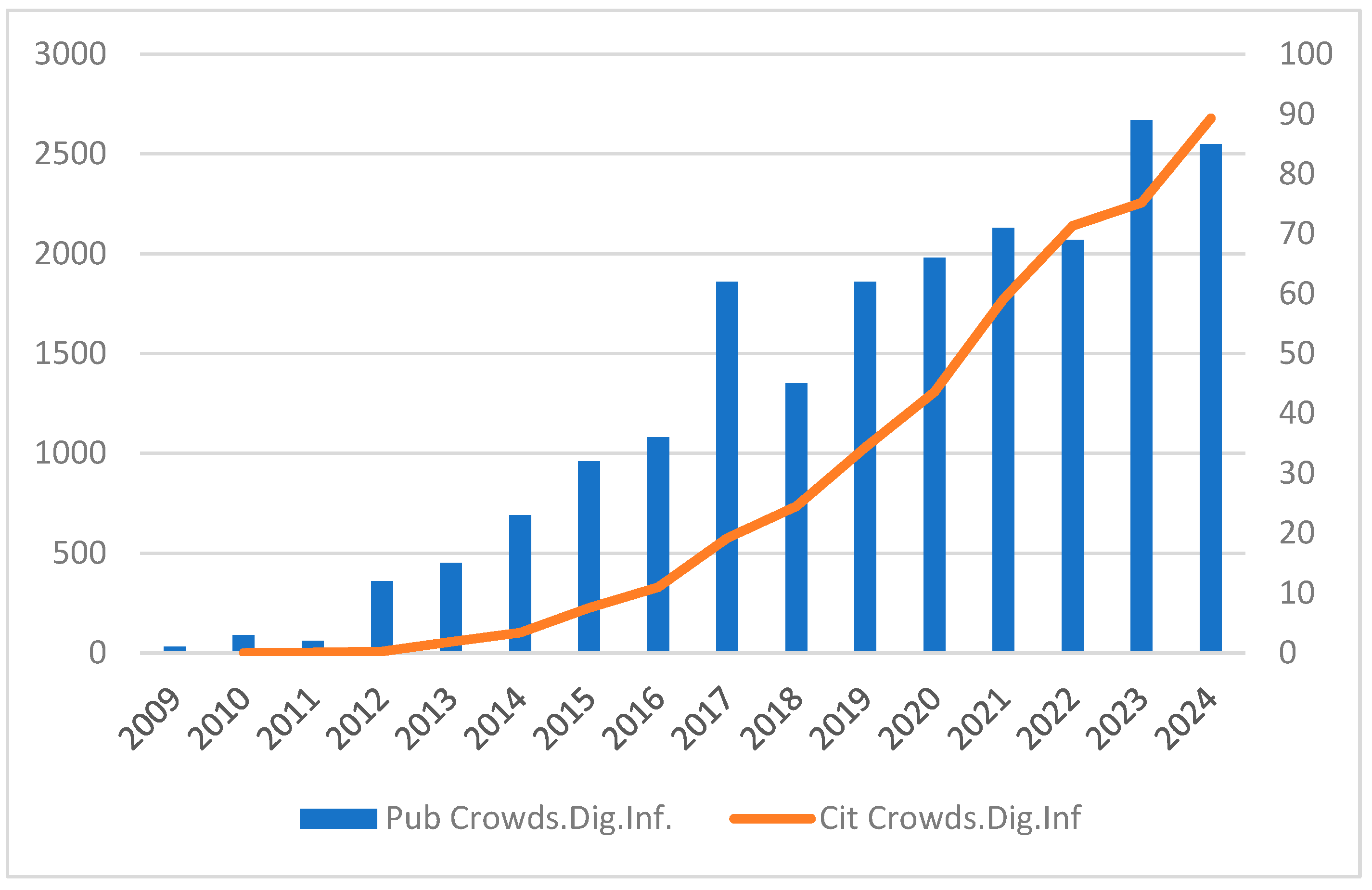
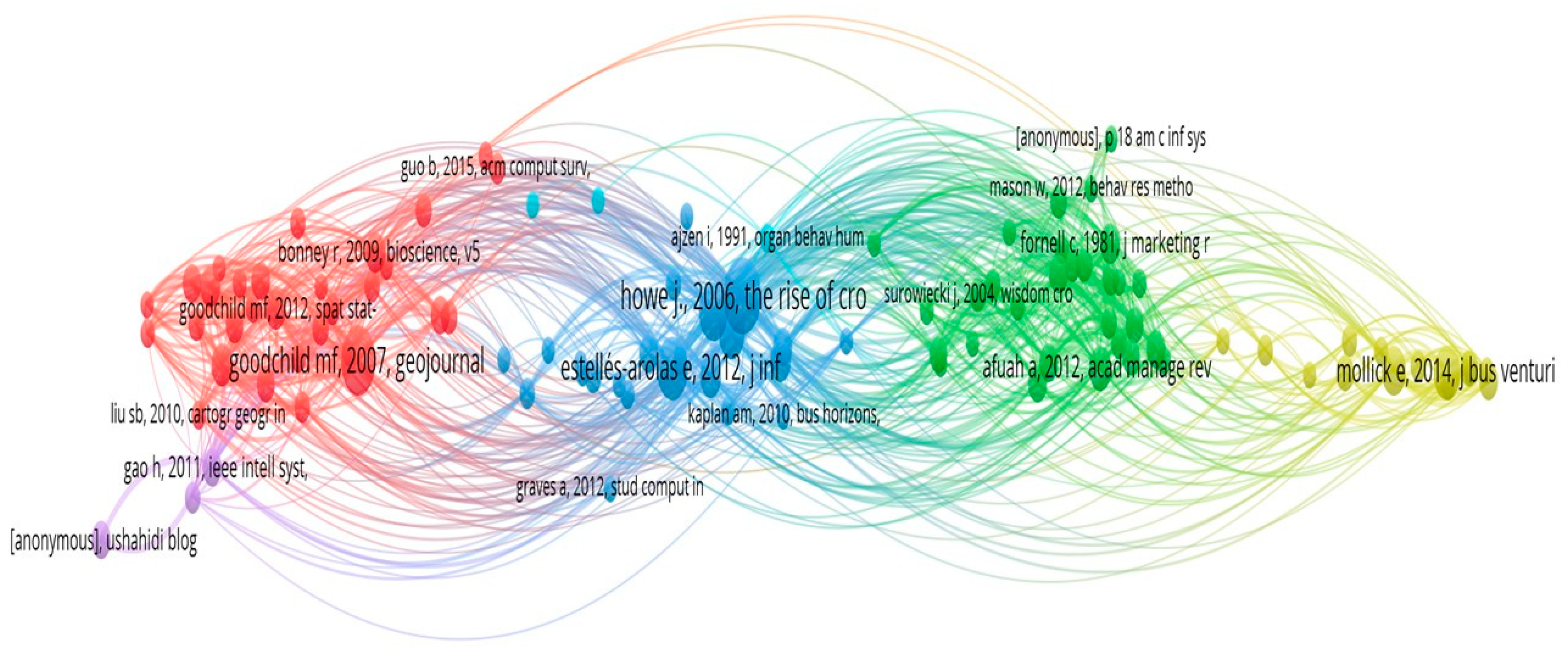
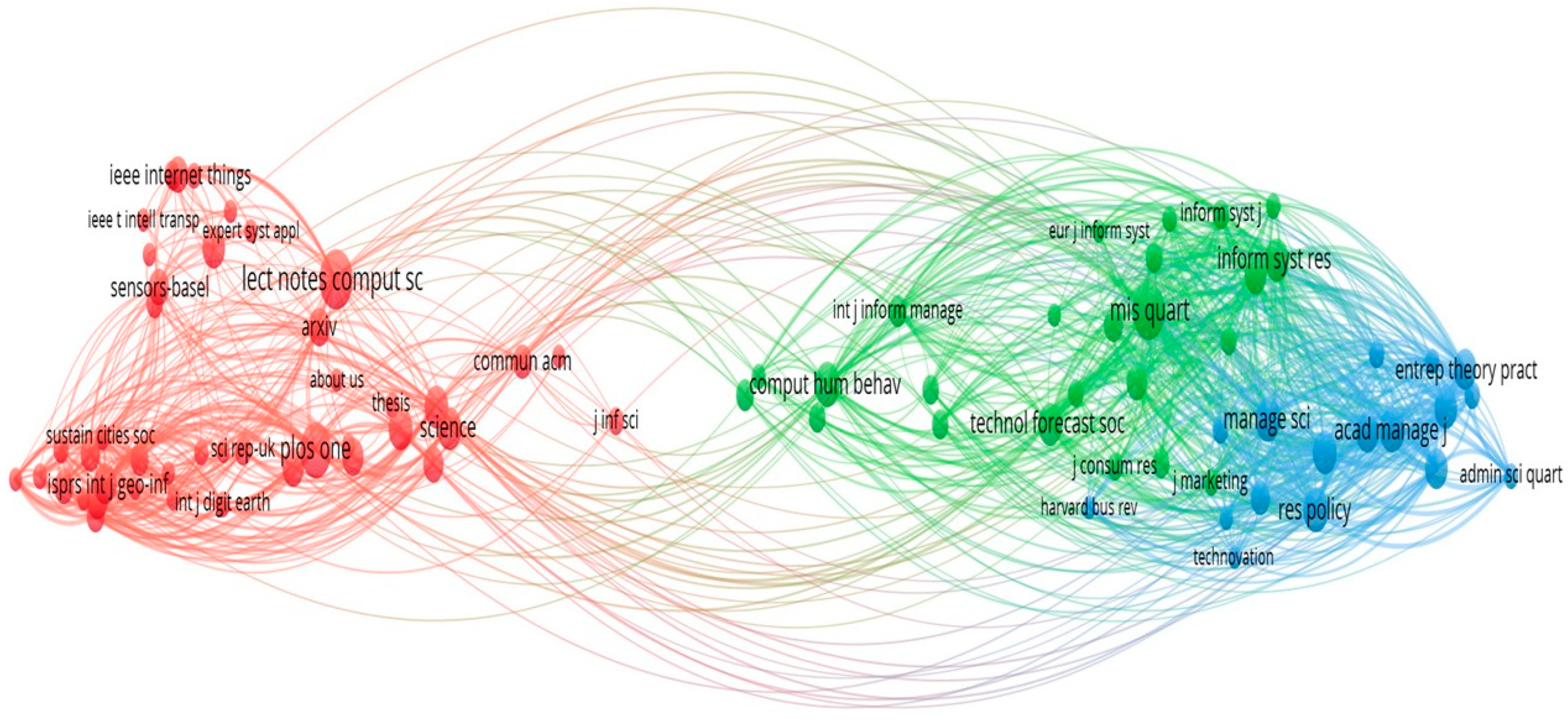

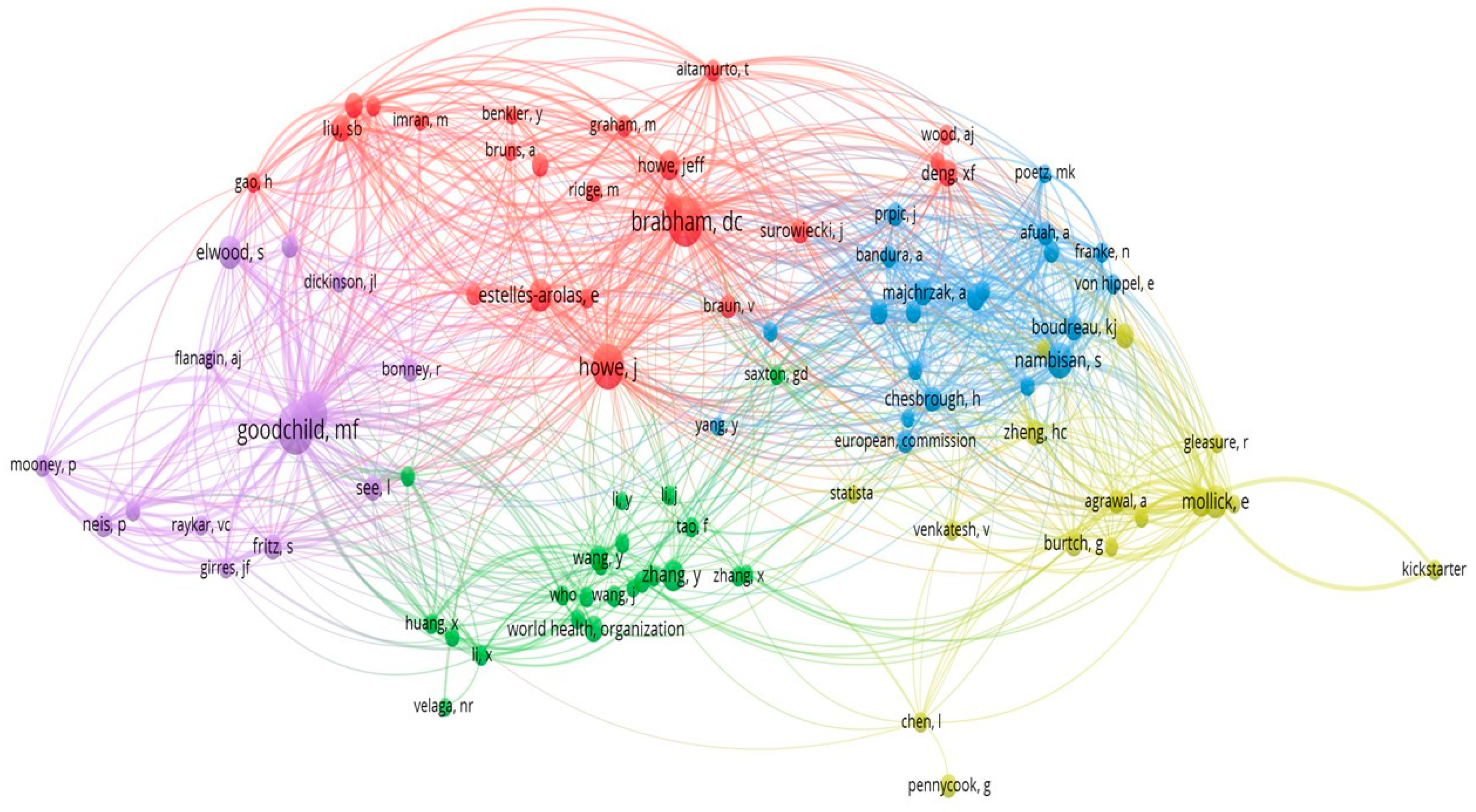
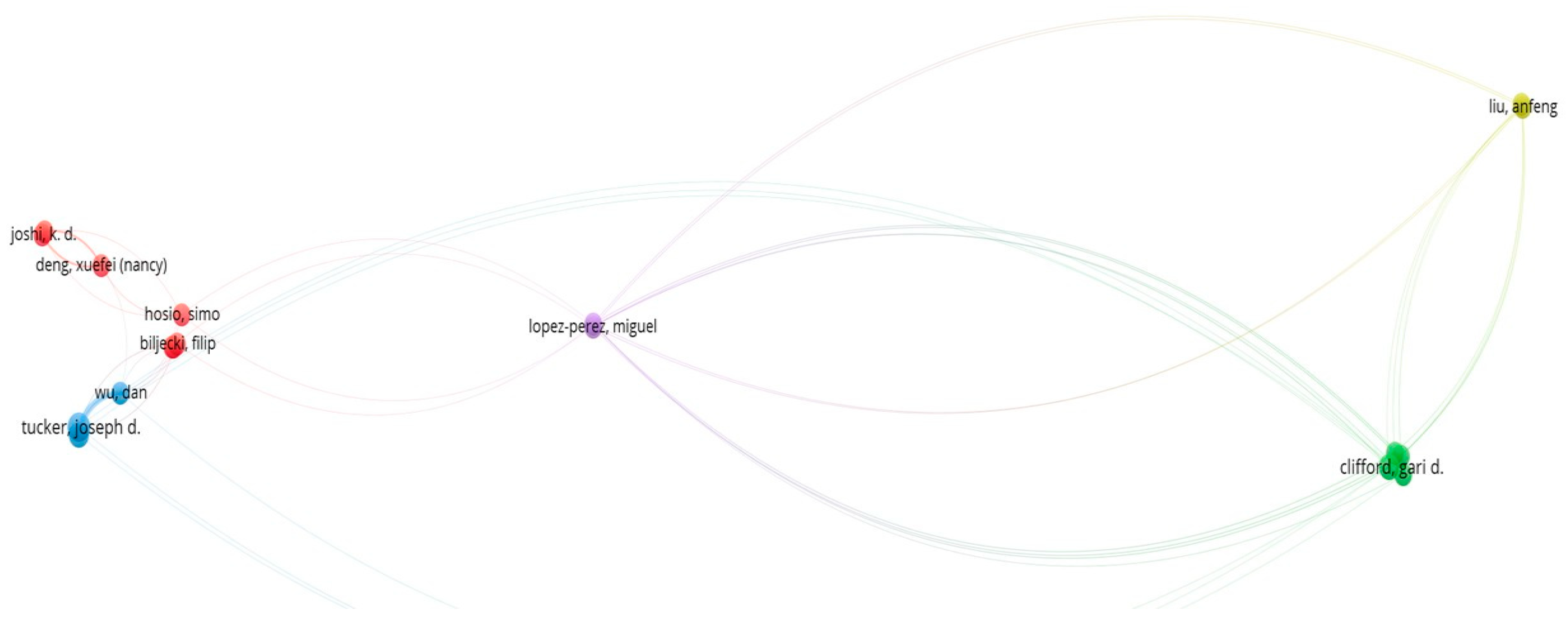
| Number of Citations | Number of Articles | Cumulative n. of Articles | % Articles | % Accumulated Articles |
|---|---|---|---|---|
| ≥200 | 8 | 8 | 1.18 | 1.18 |
| ≥150 | 5 | 13 | 0.74 | 1.91 |
| ≥100 | 10 | 23 | 1.47 | 3.39 |
| ≥50 | 37 | 60 | 5.45 | 8.84 |
| ≥25 | 63 | 123 | 9.28 | 18.11 |
| ≥10 | 154 | 277 | 22.68 | 40.80 |
| <10 | 402 | 679 | 59.20 | 100.00 |
| Total | 679 |
| Papers with the Most Citations in QT | ||||||
|---|---|---|---|---|---|---|
| R | Journal | TC | Article | Authors | Year | CY |
| 1 | TCS | 550 | “The Psychology of Fake News” | Pennycook, G and Rand, DG | 2021 | 13.50 |
| 2 | CAD | 456 | “Cloud-based design and manufacturing: A new paradigm in digital manufacturing and design innovation” | Wu, DZ; Rosen, DW; (...); Schaefer, D | 2015 | 45.60 |
| 3 | MQ | 307 | “Computer-Aided Design” | Steelman, ZR; Hammer, BI and Limayem, M | 2014 | 27.91 |
| 4 | JMIR | 296 | “Framework for Managing the COVID-19 Infodemic: Methods and Results of an Online, Crowdsourced WHO Technical Consultation” | Tangcharoensathien, V; Calleja, N; (...); Briand, S | 2020 | 59.20 |
| 5 | IATN | 268 | “Incentive Mechanisms for Crowdsensing: Crowdsourcing With Smartphones” | Yang, DJ; Xue, GL; (...); Tang, J | 2016 | 29.78 |
| 6 | EAPD | 230 | “Automated identification and characterization of parcels with OpenStreetMap and points of interest” | Liu, XJ and Long, Y | 2016 | 25.56 |
| 7 | ITPAM | 213 | “Demographic Estimation from Face Images: Human vs. Machine Performance” | Han, H; Otto, C; (...); Jain, AK | 2015 | 21.30 |
| 8 | WRR | 204 | “The NorWeST Summer Stream Temperature Model and Scenarios for the Western US: A Crowd-Sourced Database and New Geospatial Tools Foster a User Community and Predict Broad Climate Warming of Rivers and Streams” | Isaak, DJ; Wenger, SJ; (...); Parkes-Payne, S | 2017 | 25.50 |
| 9 | PNAS | 196 | “Next-generation Digital Earth” | Goodchild, MF; Guo, HD; (...); Woodgate, P | 2012 | 15.08 |
| 10 | ITAC | 191 | “Building Naturalistic Emotionally Balanced Speech Corpus by Retrieving Emotional Speech from Existing Podcast Recordings” | Lotfian, R and Busso, C | 2019 | 31.83 |
| 11 | NTWE | 186 | “Amazon Mechanical Turk and the commodification of labour” | Bergvall-Kåreborn, B and Howcroft, D | 2014 | 16.91 |
| 12 | ARPH | 176 | “Social Media- and Internet-Based Disease Surveillance for Public Health” | Aiello, AE; Renson, A and Zivich, PN | 2020 | 35.20 |
| 13 | B | 161 | “Structured crowdsourcing enables convolutional segmentation of histology images” | Amgad, M; Elfandy, H; (...); Cooper, LAD | 2019 | 26.83 |
| 14 | RS | 145 | “Sentinel-1 InSAR Coherence to Detect Floodwater in Urban Areas: Houston and Hurricane Harvey as A Test Case” | Chini, M; Pelich, R; (...); Matgen, P | 2019 | 24.17 |
| 15 | JMIR | 132 | “Towards an Artificially Empathic Conversational Agent for Mental Health Applications: System Design and User Perceptions” | Morris, RR; Kouddous, K; (...); Schueller, SM | 2018 | 18.86 |
| 16 | SD | 131 | “The COUGHVID crowdsourcing dataset, a corpus for the study of large-scale cough analysis algorithms” | Orlandic, L; Teijeiro, T and Atienza, D | 2021 | 32.75 |
| 17 | RDM | 128 | “Digital transformation, for better or worse: a critical multi-level research agenda” | Dabrowska, J; Almpanopoulou, A; (...); Ritala, P | 2022 | 42.67 |
| 18 | AMCC | 128 | “Noninvasive Fetal ECG: the PhysioNet/Computing in Cardiology Challenge 2013” | Silva, I; Behar, J; (...); Moody, GB | 2013 | 10.67 |
| 19 | AAAG | 125 | “Citizen Science in the Age of Neogeography: Utilizing Volunteered Geographic Information for Environmental Monitoring” | Connors, JP; Lei, SF and Kelly, M | 2012 | 9.62 |
| 20 | JBR | 124 | “Exploring how consumer goods companies innovate in the digital age: The role of big data analytics companies” | Mariani, MM and Wamba, SF | 2020 | 24.80 |
| R | Journal | APC | H-C | TAP | TCC | ACC | PCC | %APC | IF | ≥200 | ≥100 | ≥50 | ≥20 |
|---|---|---|---|---|---|---|---|---|---|---|---|---|---|
| 1 | IIJG | 10 | 6 | 5291 | 124 | 124 | 12.40 | 0.19 | 2.8 | 2 | |||
| 2 | S | 10 | 6 | 67,796 | 173 | 173 | 17.30 | 0.01 | 3.4 | 1 | 2 | ||
| 3 | IA | 8 | 3 | 92,961 | 36 | 36 | 4.50 | 0.01 | 3.4 | ||||
| 4 | JMIR | 8 | 5 | 8708 | 520 | 520 | 65.00 | 0.09 | 5.8 | 1 | 2 | 2 | 3 |
| 5 | TFSC | 8 | 6 | 6208 | 120 | 119 | 15.00 | 0.13 | 12.9 | 1 | 1 | ||
| 6 | SU | 7 | 5 | 90,218 | 85 | 85 | 12.14 | 0.01 | 3.3 | 2 | |||
| 7 | AJCCH | 6 | 2 | 478 | 26 | 26 | 4.33 | 1.26 | 2.1 | ||||
| 8 | IITJ | 6 | 4 | 11,183 | 26 | 26 | 4.33 | 0.05 | 8.2 | ||||
| 9 | PO | 6 | 6 | 304,806 | 207 | 207 | 34.50 | 0.00 | 2.9 | 1 | 4 | ||
| 10 | SD | 6 | 4 | 5597 | 177 | 177 | 29.50 | 0.11 | 5.8 | 1 | 1 | 2 | |
| 11 | JPHS | 5 | 4 | 1443 | 181 | 180 | 36.20 | 0.35 | 3.5 | 1 | 1 | 3 | |
| 12 | JAIST | 5 | 4 | 1758 | 61 | 61 | 12.20 | 0.28 | 2.8 | 1 | |||
| 13 | RS | 5 | 4 | 36,955 | 256 | 253 | 51.20 | 0.01 | 4.2 | 1 | 2 | 3 |
| R | Keyword (2009–2022) | Oc | Co | Keyword (2023–2025) | Oc | Co |
|---|---|---|---|---|---|---|
| 1 | crowdsourcing | 187 | 192 | crowdsourcing | 63 | 56 |
| 2 | citizen science | 24 | 35 | crowdfunding | 17 | 11 |
| 3 | social media | 22 | 44 | digital platforms | 11 | 10 |
| 4 | big data | 15 | 36 | machine learning | 10 | 9 |
| 5 | Vgi | 15 | 22 | blockchain | 9 | 20 |
| 6 | digital humanities | 14 | 20 | digital twin | 9 | 10 |
| 7 | innovation | 9 | 13 | cultural heritage | 8 | 8 |
| 8 | COVID-19 | 7 | 13 | task analysis | 7 | 20 |
| 9 | internet | 7 | 6 | citizen science | 6 | 6 |
| 10 | internet of things | 7 | 9 | deep learning | 6 | 7 |
| 11 | machine learning | 7 | 6 | digital health | 5 | 3 |
| 12 | open innovation | 7 | 11 | online communities | 5 | 6 |
| 13 | emergency management | 6 | 17 | social media | 5 | 4 |
| 14 | openstreetmap | 6 | 9 | artificial intelligence | 4 | 5 |
| 15 | sustainability | 6 | 8 | crowdwork | 4 | 3 |
| 16 | cloud computing | 5 | 8 | digital transformation | 4 | 4 |
| 17 | collaboration | 5 | 8 | photogrammetry | 4 | 3 |
| 18 | digital humanitarianism | 5 | 9 | privacy | 4 | 12 |
| 19 | privacy | 5 | 5 | affordances | 3 | 3 |
| 20 | smartphone | 5 | 8 | authentication | 3 | 7 |
| 21 | surveillance | 5 | 9 | built environment | 3 | 1 |
| 22 | artificial intelligence | 4 | 13 | case study | 3 | 5 |
| 23 | co-creation | 4 | 6 | citizen participation | 3 | 0 |
| 24 | crisis informatics | 4 | 17 | COVID-19 | 3 | 1 |
| 25 | critical cartography | 4 | 6 | digital entrepreneurship | 3 | 2 |
| 26 | crowdsensing | 4 | 4 | digital heritage | 3 | 2 |
| 27 | data collection | 4 | 6 | entrepreneurship | 3 | 5 |
| 28 | digital health | 4 | 8 | fairness | 3 | 5 |
| 29 | digital libraries | 4 | 10 | information sharing | 3 | 7 |
| 30 | gamification | 4 | 4 | misinformation | 3 | 5 |
| 31 | metadata | 4 | 6 | Mturk | 3 | 3 |
| 32 | online communities | 4 | 8 | reinforcement learning | 3 | 5 |
| 33 | participatory sensing | 4 | 7 | reliability | 3 | 7 |
| 34 | research libraries | 4 | 6 | sensors | 3 | 9 |
| 36 | 4 | 7 | sharing economy | 3 | 1 | |
| smart manufacturing | 3 | 5 | ||||
| smartphone | 3 | 2 | ||||
| surveillance | 3 | 6 |
Disclaimer/Publisher’s Note: The statements, opinions and data contained in all publications are solely those of the individual author(s) and contributor(s) and not of MDPI and/or the editor(s). MDPI and/or the editor(s) disclaim responsibility for any injury to people or property resulting from any ideas, methods, instructions or products referred to in the content. |
© 2025 by the authors. Licensee MDPI, Basel, Switzerland. This article is an open access article distributed under the terms and conditions of the Creative Commons Attribution (CC BY) license (https://creativecommons.org/licenses/by/4.0/).
Share and Cite
Garrigos-Simon, F.J.; Narangajavana-Kaosiri, Y. Crowdsourcing and Digital Information: Looking for a Future Research Agenda. Information 2025, 16, 536. https://doi.org/10.3390/info16070536
Garrigos-Simon FJ, Narangajavana-Kaosiri Y. Crowdsourcing and Digital Information: Looking for a Future Research Agenda. Information. 2025; 16(7):536. https://doi.org/10.3390/info16070536
Chicago/Turabian StyleGarrigos-Simon, Fernando J., and Yeamduan Narangajavana-Kaosiri. 2025. "Crowdsourcing and Digital Information: Looking for a Future Research Agenda" Information 16, no. 7: 536. https://doi.org/10.3390/info16070536
APA StyleGarrigos-Simon, F. J., & Narangajavana-Kaosiri, Y. (2025). Crowdsourcing and Digital Information: Looking for a Future Research Agenda. Information, 16(7), 536. https://doi.org/10.3390/info16070536







